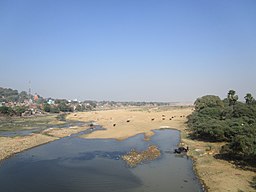Falgu river
| Phalgu River | |
| River | |
|
Phalgu River at Gaya
|
|
| Country | India |
|---|---|
| State | Bihar |
| City | Gaya |
| Source | Confluence of Lilajan and Mohana rivers |
| - location | near Gaya |
| - coordinates | 24°43′41″N 85°00′47″E / 24.72806°N 85.01306°E |
| Mouth | Punpun River |
The Phalgu or Falgu, a river that flows past Gaya, India in the Indian state of Bihar, is a sacred river for Hindus and Buddhists. In ancient scriptures, it is called the Nairañjanā in Sanskrit.
The Phalgu is formed by the confluence, some 3 kilometres (2 mi) below Bodh Gaya, of the Lilajan (also called Niranjan or Nilanjan) and the Mohana, two large hill streams each of which is over 270 metres (300 yd) wide. The Phalgu is also mentioned as Niranjan. The united stream flows on to the north past the town of Gaya, where it attains a breadth of over 820 metres (900 yd). The Phalgu here passes by a high rocky bank, on the steep sides of which are many paved stairs leading down to the river bed, while high above are the Vishnupad Mandir, with many minor shrines around it. It then runs in a north-easterly direction for about 27 kilometres (17 mi), and opposite the Barabar hills it again takes the name of Mohana, and divides into two branches which eventually flow into a branch of the Punpun.
The Phalgu like its confluent streams, Lilajan and Mohana, is subject to high floods during the monsoons but in other seasons of the year it dwindles to a stream wandering through a wide expanse of sand.
The portion of the course of the Phalgu flowing by Gaya is sacred to the Hindus. It is the first holy site visited by the pilgrim and here his first offering must be made for the souls of his ancestors. According to the Gaya Mahatmya, which forms part of the Vayu Purana, the Phalgu is the embodiment of Vishnu himself. One tradition states that it formerly flowed with milk.
According to Hindu belief, the soul wanders after death until pindadan, or religious service seeking salvation for the dead from the cycle of rebirth, is performed. The fortnight-long pitrapaksh period is considered auspicious to offer pindadan. The 15 days of the waning moon during the Hindu month of Ashvin are known as pitrapaksh. Pindadan is traditionally offered on the banks of the Phalgu at Gaya. It is mandatory for Hindu devotees offering pindadan to shave their heads and take a holy dip and head for the Baitarni pond. The prayers are performed at the Vishnupad Mandir. Priests, known as Gaywal-pandas, conduct the ritual. Thousands of Hindus visit Gaya for the purpose of pindadan.
...
Wikipedia

